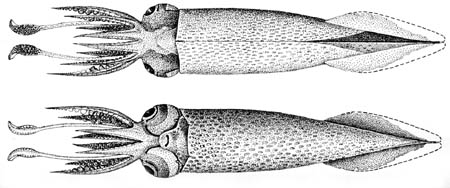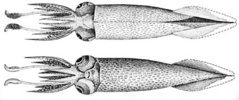Teuthowenia maculata
Richard E. Young and Katharina M. Mangold (1922-2003)Introduction
T. maculata is one of three similar species in the genus. The largest known specimen is an immature male of 143 mm ML. This is a small meso- to bathypelagic squid that is found in the tropical Eastern Atlantic. A detailed account of this species is given by N. Voss (1985).
Characteristics
- Arms
- Arms I and II of males with 3-4 series of suckers on modified tips.
- Arms I and II of males with 25-27 normal suckers proximal to modified ends.
- Largest arm III suckers 3 times basal suckers in diameter (at least 3.2% of GL in diameter).
 Click on an image to view larger version & data in a new window
Click on an image to view larger version & data in a new window

Figure. Oral views of arm tips of T. maculata. Top - Arm I tip. Bottom - Arm II tip. These are the extreme tips of the arms and occupy between just 3% and 8% of the arm length. Subadult male, 143 mm GL. Drawings from Voss, 1985, pp. 33, 34.
- Mantle
- Single-point tubercle, poorly developed, at each funnel-mantle fusion.
- Tentacles
- Largest club suckers with 22-26 teeth.
Comments
The extent of the modifications to the arms of mature males is unknown. Additional details of the description of T. maculata can be found here.
Life history
The paralarval stage of T. maculata terminates at about 55 - 60 mm GL when the eyes become sessile. Generally a tubercule at the mantle-funnel fusion is not present in paralarvae. This species has chromatophores that are smaller, more numerous and more densely arranged than in the other species of the genus.
Distribution
Vertical distribution

Data from opening-closing nets on the vertical distribution of this species have been reported at 11° N, 20° W (Lu and Clarke, 1975). Paralarvae up to about 20 mm ML were captured mostly in the upper 100 m during both the day and the night. By about 40 - 50 mm ML three of the four squid captured were taken between 500 - 700 m day and night; the fourth had apparently wandered upward at night and was taken at 300 - 400 m. The sparse data suggest that these squid undergo ontogenetic descent without diel vertical migration. Vertical distribution chart modified from Lu and Clarke, 1975.
Geographical distribution

T. maculata is known only from the tropical Eastern Atlantic in oceanic waters whose depth exceeds 1000 m. At the northern end of its range, it appears to be confined to the oceanographically distinct region of the Mauritanian Upwelling (Voss, 1985). For a comparison with the distribution of the other two species, see "Teuthowenia." Geographical distribution chart modified from Voss, 1985.
References
Lu, C. C. and M. R. Clarke, 1975. Vertical Distribution of Cephalopods at 11° N 20° W in the North Atlantic. Journal of the Marine Biological Association of the United Kingdom, 55 (2): 369-389.
Voss, N. A. 1980. A generic revision of the Cranchiidae (Cephalopoda; Oegopsida). Bull. Mar. Sci. 30: 365-412.
Voss, N. A. 1985. Systematics, biology and biogeography of the cranchiid cephalopod genus Teuthowenia (Oegopsida). Bull. Mar. Sci. 36: 1-85.
Title Illustrations

| Scientific Name | Teuthowenia maculata |
|---|---|
| Reference | Voss, N. A. 1985. Systematics, biology and biogeography of the cranchiid cephalopod genus Teuthowenia (Oegopsida). Bull. Mar. Sci. 36: 1-85. |
| Sex | Male |
| Life Cycle Stage | juvenile |
| View | dorsal, ventral |
| Size | 123 mm GL |
| Type | hypotype |
| Copyright | © Bulletin of Marine Science |
About This Page
Drawings from Voss (1985) printed with the Permission of the Bulletin of Marine Science.

University of Hawaii, Honolulu, HI, USA
Katharina M. Mangold (1922-2003)

Laboratoire Arago, Banyuls-Sur-Mer, France
Page copyright © 1999 and Katharina M. Mangold (1922-2003)
 Page: Tree of Life
Teuthowenia maculata .
Authored by
Richard E. Young and Katharina M. Mangold (1922-2003).
The TEXT of this page is licensed under the
Creative Commons Attribution-NonCommercial License - Version 3.0. Note that images and other media
featured on this page are each governed by their own license, and they may or may not be available
for reuse. Click on an image or a media link to access the media data window, which provides the
relevant licensing information. For the general terms and conditions of ToL material reuse and
redistribution, please see the Tree of Life Copyright
Policies.
Page: Tree of Life
Teuthowenia maculata .
Authored by
Richard E. Young and Katharina M. Mangold (1922-2003).
The TEXT of this page is licensed under the
Creative Commons Attribution-NonCommercial License - Version 3.0. Note that images and other media
featured on this page are each governed by their own license, and they may or may not be available
for reuse. Click on an image or a media link to access the media data window, which provides the
relevant licensing information. For the general terms and conditions of ToL material reuse and
redistribution, please see the Tree of Life Copyright
Policies.
Citing this page:
Young, Richard E. and Katharina M. Mangold (1922-2003). 1999. Teuthowenia maculata . Version 01 January 1999. http://tolweb.org/Teuthowenia_maculata/19614/1999.01.01 in The Tree of Life Web Project, http://tolweb.org/














 Go to quick links
Go to quick search
Go to navigation for this section of the ToL site
Go to detailed links for the ToL site
Go to quick links
Go to quick search
Go to navigation for this section of the ToL site
Go to detailed links for the ToL site